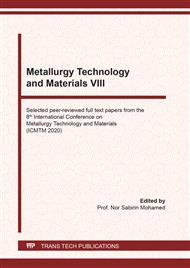[1]
G. Azimi, H.M. Kwon, K.K. Varanasi. Superhydrophobic surfaces by laser ablation of rare-earth oxide ceramics, MRS Comm. 4 (2014) 95–99.
DOI: 10.1557/mrc.2014.20
Google Scholar
[2]
T. Verho, C. Bower, P. Andrew, S. Franssila, O. Ikkala, R.H. Ras, Mechanically durable superhydrophobic surfaces, Adv. Mater. 23 (2011) 673-678.
DOI: 10.1002/adma.201003129
Google Scholar
[3]
G. Azimi, R. Dhiman, H.M. Kwon, A.T. Paxson, K.K. Varanasi, Hydrophobicity of rare-earth oxide ceramics, Nat. Mater. 12 (2013) 315–320.
DOI: 10.1038/nmat3545
Google Scholar
[4]
Y. Tian, L. Jiang, Wetting: Intrinsically robust hydrophobicity, Nat. Mater. 12 (2013) 291–292.
Google Scholar
[5]
I.K. Oh, K. Kim, Z. Lee, K.Y. Ko, C.W. Lee, S.J. Lee, et al., Hydrophobicity of rare earth oxides grown by atomic layer deposition, Chem. Mater. 27 (2015) 148–156.
DOI: 10.1021/cm503659d
Google Scholar
[6]
F. Pedraza, S.A. Mahadik, B. Bouchaud, Synthesis of ceria based superhydrophobic coating on Ni20Cr substrate via cathodic electroc, Phys. Chem. Chem. Phys. 17 (2015) 31750–31757.
DOI: 10.1039/c5cp04723d
Google Scholar
[7]
S. Khan, G. Azimi, B. Yildiz, K.K. Varanasi, Role of surface oxygen-to-metal ratio on the wettability of rare-earth oxides, Appl. Phys. Lett. 106 (2015) 061601.
DOI: 10.1063/1.4907756
Google Scholar
[8]
D.J. Preston, N. Miljkovic, J. Sack, R. Enright, J. Queemey, E.N. Wang, Effect of hydrocarbon adsorption on the wettability of rare earth oxide ceramics, Appl. Phys. Lett. 105 (2014) 011601.
DOI: 10.1063/1.4886410
Google Scholar
[9]
K. Nakayama, T. Hiraga, C. Zhu, E. Tsuji, Y. Aoki, H. Habazaki, Facile preparation of self-healing superhydrophobic CeO2 surface by electrochemical processes, Appl. Surf. Sci. 423 (2017) 968-976.
DOI: 10.1016/j.apsusc.2017.07.012
Google Scholar
[10]
J. Wang, J. Liu, N. Neate, M. Bai, F. Xu, T. Hussain, et al., Investigation on time-dependent wetting behavior of Ni-Cu-P ternary coating, J. Alloys. Compd. 765 (2018) 221-228.
DOI: 10.1016/j.jallcom.2018.06.239
Google Scholar
[11]
J. Xu, S.S. Xin, P.H. Han, R.Y. Ma, M.C. Li, Cerium chemical conversion coatings for corrosion protection of stainless steels in hot seawater environments, Mater. Corros. 64 (2013) 619–624.
DOI: 10.1002/maco.201206752
Google Scholar
[12]
L. Martinez, E. Roman, J.L. de Segovia, S. Poupard, J. Creus, F. Pedraza, Surface study of cerium oxide based coatings obtained by cathodic electrodeposition on zinc, Appl. Surf. Sci. 257 (2011) 6202–6207.
DOI: 10.1016/j.apsusc.2011.02.033
Google Scholar
[13]
D. Zhang, Y. Ma, H. Feng, Y. Hao, Adsorption of Cr (VI) from aqueous solution using carbon-microsilica composite adsorbent, J. Chil. Chem. Soc. 57 (2012)964–968.
DOI: 10.4067/s0717-97072012000100002
Google Scholar
[14]
S. Hosseini, H. Savaloni, M.G. Shahraki, Design and engineering of sculptured nano-structures for application in hydrophobicity, J. Ind. Eng. Chem. 45 (2017) 391–403.
DOI: 10.1016/j.jiec.2016.10.008
Google Scholar


